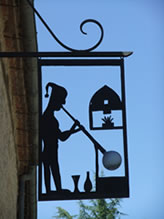| |
Read 10QI
Home
Japanese Knotweed
Bo Nightingale |
|
|
|
10Q
Japanese Knotweed
Thug or Therapy?
10QuiteInteresting
QuestionsFactsFiguresPointsDatesEvents
This site and these pages are currently under construction
|
What is a Weed? |
A weed is simply a plant in the wrong place. As a gardener I was once asked to pull up a carpet of dainty pink Oxalis covering the ground in a Raspberry cage in the grounds of a large country house in Dogmersfield, Hampshire. The Lady of the house simply did not wish them to be there. Arguably when we thin out rows of lettice seedlings, the ones we remove are weeds.
|
|
What is a pernicious weed? |
A weed may be regarded as a slight irritation. A pernicious weed is something quite different. Perennial and persistent, the removal of pernicious weeds can quickly become a battle of attrition particularly if you choose to be environmentally friendly and not use herbicides.
Alan Titchmarsh former presenter of BBC Gardeners World regailed the story of how he had dug up a dandelion and nailed the root to his garden shed door. Five years later he returned, unpinned the root and planted it. Within weeks it had sprouted new green leaves.
Another well know example of 'weed' seeds lying dormant for many years is the Field Poppy. The seeds can remain perfectly viable for tens of years until the soil is disturbed such as in World War 1 when of many acres of ground were subject to artilliary shelling during the many battles. The following year the same fields were blood red with poppy flowers.
The third example is commonly called Horsetail or
Mares Tail and botanically known as Equisetum arvense – an ancient plant which lived during the dinosaur age. Deeply rooted its rhizomes can grow as deeply as 7 feet into the soil and be extremely difficult to eradicate without the use of chemicals. However, it has quite pretty delicate foliage and could be regarded as aesthetically pleasing for the more relaxed gardener.
|
10QI 3 |
What is a native plant? |
All the above are considered to be native to this country. They have arrived in this country as part of natural evolution or as part of the activites of humans as they travelled across land or sea in the then known world.
|
10QI 4 |
Non native plants |
Since ancient times trade routes have existed, for example The Silk Road. However, when Europeans started sailing westwards across the Atlantic and eastwards around the Cape of Good Hope, South Africa and to the 'new world' two things happened. Firstly, a lot of money was made and secondly a lot of curiosities were discovered including strange new animals, birds and plants. |
10QI 5 |
Welcome Imports |
Familiar summer bedding plants first arrived at this time including Busy Lizzies, Pelargoniums (non-native
Geraniums) and Begonias.
|
10QI 6 |
ASBO’s for Gardners |
In the 1800’s German Botanist Philipp Franz Bathasar Von Siebold travelled to Japan with the Dutch East India Company. On the side of an active volcano he discovered Fallopia Japonica thriving where little else grew. He sent the plant back to Europe and it was added to the plant collection of the Royal Botanic Gardens in Kew in 1850
Today this plant is known in the UK as Japanese Knotweed and has been described as a 'thug' by the Royal Horticultural Society and is classified under the Anti-Social Behaviour, Crime and Policing Act 2014 as an invasive non-native plant.
Under the Wildlife and Countryside Act 1981 it is an offence to cause Japanese Knotweed to grow in the wild. You could be fined up to £5,000 (as at 2016) or be sent to prison if you allow contaminated soil or plant material from any waste you transfer to spread into the wild. https://www.gov.uk/guidance/prevent-japanese-knotweed-from-spreading
|
10QI 7 |
Plant Thug Characteristics |
• at the height of summer it can grow to a height of 3 – 4 meters high
• it has a tenacious system of rhizomes which can grow to 3 meters in depth
• these rhizomes can grow 7 meters horizontally in every direction from each plant year on year.
• year on year these rhizomes have the potential to grow plants which form impenetrable ‘stands’
• if the rhizomes are cut, for example by digging, the tiniest section has the potential to form a new plant.
|
10QI 8 |
Commercial Impact |
The cost to commercial developers can be significant. The 10 acre site of the London 2012 Olympic Velodrome and Aquatic Centre at Stratford contained a significant amount of Japanese Knotweed. The licensed contractors could not use herbicide because of the proximity of aquafers and water bodies. Additionally, it takes at least 3 seasons of application before the herbicides fully eradicate the plant. In this instance the soil was dug out to a depth of at least 3 meters and removed to a licensed landfill site where it was buried in a sealed container at an estimated cost of £70 million.
|
10QI 9 |
Residential Property |
Japanese knotweed can grow through the minutest of fissures in concrete, brickwork and other solid building materials causing considerable damage potentially undermining the structural integrity of domestic dwellings. The remedial cost together with the cost of removing the weed can be extremely expensive.
Under the Law Society’s transaction protocol, in 2013 an additional question was added to the Sellers Property Information form TA6 which required the seller to answer the question “is the property affected by knotweed?” The options are: Yes, No, Not Known. To answer Yes may cause issues with not only the buyer but also their lender should they require a mortgage. If the answer is Not Known this too may cause problems because of the uncertainty of the situation. In a recent development, if the answer is stated in the Property Information form is No the seller may still be liable if, in fact, it transpires that knotweed is, in fact, growing within the boundary of the property. The cost to employ a specialist firm to remove Japanese Knotweed can be extremely expensive running into thousands of pounds. Under current legislation the plant is classified as “controlled waste” under part 2 of the Environmental Protection Act 1990 and must be disposed at licensed land fill sites.
Increasingly lenders are extremely wary of offering mortgages where the plant is likely to be found and this could make selling a property with Japanese knotweed within or near its boundaries extremely difficult.
|
10QI 10 |
Traditional Therapy |
It seems highly unlikely that we will ever eradicate Fallopia Japonica from our land but with increased awareness and environmentally friendly techniques such as steam sterilisation of the contaminated soil, hopefully we can begin to control it.
Indeed, under control it may even provide some benefits. In some countries the new shoots are actively harvested as a food item and some bee keepers regard its nectar rich flowers as a useful source of food for their bees during the late summer.
The roots of Itadori have been used in the far east as a herbal medicine. Itadori can be used as an anti-inflammatory, a laxative, for oral hygiene and cardiovascular health, treatment of acute hepatitis, kidney stones, high cholesterol, and skin rashes amongst a host of other uses.
In his book Invasive Plant Medicine: The Ecological Benefits and Healing Abilities of Invasives, Timothy Lee Scott highlights the potential of using Japanese Knotweed as a potential cure for Lyme’s disease.
|
| |
|
Page Under Construction. Email bo@networkingnaturally.com if you would like to comment or contribute to the content
Networking Naturally is not responsible for the content of external sites. Read more....
If you have a comment or would like to submit content
Send an email to
bo@networkingnaturally.com
|
|
|
|
|
New
'MicroRead'
MicroReadLatest

The Glass Blowers Sign

Stained Glass windows
in St Catherines Church

|
|

